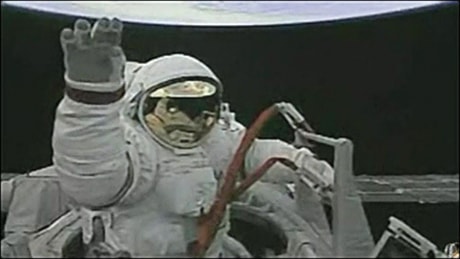The U.S. National Aeronautics and Space Agency (NASA) recently released the full data on last year’s mission to find out whether there are usable amounts of water on the moon, and the news is good. There is plenty of frozen water on the moon, plus frozen gases like methane, oxygen and hydrogen that would be useful for making rocket fuel.
This will be very helpful to the Chinese and the Indians when they start to build their bases on the moon.
The United States is not going back to the moon. That plan died when President Obama cancelled the first new American launch vehicles in 25 years, the Ares series of rockets, last February. That put an end to NASA’s hopes of returning to the moon by 2020 and building bases there for further manned exploration of the solar system.
Obama promised to support the development of commercial manned spacecraft instead, but those will only be capable of low-orbit operations for the foreseeable future. Gen. Charles Bolden, the current head of NASA, loyally chimed in with blue-sky talk of a glowing future for the agency.
“Imagine trips to Mars that take weeks instead of nearly a year; people fanning out across the inner solar system, exploring the moon, asteroids and Mars nearly simultaneously in a steady stream of firsts,” burbled the general. “That is what the president’s plan for NASA will enable, once we develop the new capabilities to make it a reality.”
Yes, and if we had some ham we could have ham and eggs, if we had some eggs.
The United States has already passed its Tordesillas moment (and so has Russia).
The Treaty of Tordesillas, signed in 1494, two years after Christopher Columbus became the first European to land in the Americas, divided the newly discovered lands beyond Europe between Spain and Portugal along a meridian just west of the Cape Verde islands. It was arrogant, of course, but there were no other countries in the business of maritime exploration at the time.
Within a hundred years, the English, the French and the Dutch had piled in, and Spanish and Portuguese power was falling fast. In the end, England’s success in appropriating very large amounts of territory led to English becoming the dominant world language. This is neither a good nor a bad outcome, but it is certainly a significant one and it has some relevance to the current situation.
Russia (or rather, the old Soviet Union) was the first into space, but the United States rapidly overtook it, and for several decades they jointly dominated the exploration of near space. But the U.S. threw its lead away in 1973, cancelling the lunar exploration program when there were still three Apollo voyages scheduled.
Mike Griffin, NASA’s former head, said of Obama’s decision early this year: “Only once previously has a U.S. president recommended to the Congress that this nation take a backward step in space. On that occasion, President Nixon cancelled the Apollo program, a decision which will come to be regarded as one of the most strategically bankrupt decisions in human history. If such a thing is possible, this decision is even worse.”
The recent confirmation by NASA that there is plentiful water as well as hydrogen, methane and ammonia available in frozen form in the lunar soil means that lunar bases are a viable option — and lunar bases are essential to any program that aims to go to the other planets of this system.
You can move beyond traditional rocket fuels and come up with a fancy new system to provide the energy to drive your space ships, but you still have to have reaction mass. That will account for at least 90 per cent of the weight of any vessel that ventures beyond near-Earth space, and as long as you have to haul your reaction mass all the way up from Earth’s deep gravity well, space flight is going to remain cripplingly expensive.
If you could get it on the moon, on the other hand, you would only be dealing with one-sixth of the Earth’s gravity. What the recent mission showed that there is not just reaction mass there, but the raw materials with which to make conventional rocket fuels and enough water, the heaviest element in any life-support system, to make human bases there possible.
China and India have the ambition and the money will be there soon enough. Both China and India have already put unmanned space vehicles into lunar orbit and China has already carried out manned flights in Earth orbit. These are probably the countries that own the future in space.
Gwynne Dyer is a Canadian journalist living in London His new book, Crawling from the Wreckage, has just been published in Canada by Random House.
